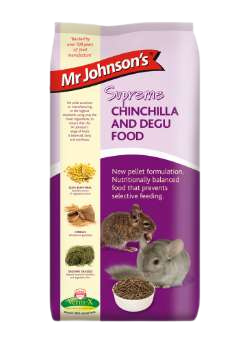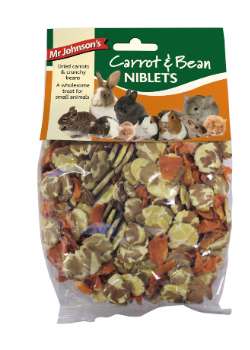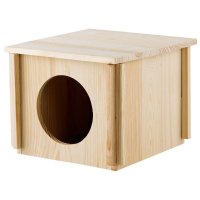
Feeding the correct food to your chinchilla is essential for maintaining good health. Fibrous feed is required for normal digestive function and for dental wear. In the wild a chinchilla’s diet would be high in fibre so it’s essential the diet you feed them supplies them with this fibre.
Chinchilla’s should be fed twice a day, dividing their daily requirements into two meals and feeding morning and evening and only refilling the bowl once empty.
What to feed your Chinchilla?
Chinchilla’s require diets that are high in fibre therefore a high proportion of their diet should be made up if good quality hay and this should be fed together with a good quality pellet or nugget.
There are various types of chinchilla foods on the market but the best food comes in pellet/nugget form:
Pellets/nuggets – a single tasty pellet/nugget that’s easy to digest, contains all the goodness in every mouthful thus preventing the potential to selectively feed.
Mr Johnson’s Supreme Chinchilla & Degu Food is a pellet full of all the essential nutrients your chinchilla will need when fed with good quality hay.
Fresh clean water should always be available.
Your chinchilla’s diet should never be changed suddenly. Abrupt changes in their diet could trigger digestive upsets, especially in baby chinchilla’s or chinchilla’s that are stressed (for example if they have moved to a new home). If you want to change your pet’s diet, it is recommended that this change takes place gradually over a 10 day period. This can be done by mixing small quantities of the new food in with their existing food, while reducing their existing food proportionally until the food is fully changed over.
 Unlimited access to good quality hay is essential as part of a healthy diet for chinchilla’s. Hay not only meets a chinchilla’s basic nutritional requirements, but it helps to keep your pet occupied, reducing boredom and hence helping to prevent some behavioural problems. Eating lots of grass and hay, which is fiberous helps to wear down a chinchilla’s front teeth. If a chinchilla’s teeth become too long they can have difficulties with eating. It also provides the correct type of fibre needed to maintain healthy gut movements. Chinchillas require good quality hay as a staple part of their daily diet. Always ensure you feed good quality hay that’s dry, clean and fresh.
Unlimited access to good quality hay is essential as part of a healthy diet for chinchilla’s. Hay not only meets a chinchilla’s basic nutritional requirements, but it helps to keep your pet occupied, reducing boredom and hence helping to prevent some behavioural problems. Eating lots of grass and hay, which is fiberous helps to wear down a chinchilla’s front teeth. If a chinchilla’s teeth become too long they can have difficulties with eating. It also provides the correct type of fibre needed to maintain healthy gut movements. Chinchillas require good quality hay as a staple part of their daily diet. Always ensure you feed good quality hay that’s dry, clean and fresh.
Chinchilla’s love to eat fruit & vegetables but too much or the wrong type can be harmful so limit how much they eat each day. They require a diet low in fat & sugar.
Fruit – try fruits with seeds, not stones or pits, e.g. raisins (only a few as naturally sweet) , dried cranberries, dried strawberries, dried blueberries, dried rose hips, a banana chip, or a piece of apple, pear, grape, or kiwi.
Vegetables -e.g. piece of carrot, flaked peas, parsley, chard, romaine, a dandelion leaf (small and washed). Avoid anything gas forming, e.g. broccoli, cabbage. All greens & fruit should be washed before feeding.
Your chinchilla should have a supply of fresh clean water constantly available and this is best dispensed from a water bottle secured to their cage. The water should be changed daily and bottles cleaned regularly.
Ideally chinchillas should be kept in a wire mesh (which should have a mesh no larger than 15mm x 15mm) that extends across the floor wire mesh (which should have a mesh no larger than 15mm x 15mm) that extends around all 6 sides including the floor. Wooden shelves should be placed to allow access away from the mesh floor so conditions like bumble foot do not occur. 90cm X 60cm X 45cm is the minimum sized cage for a single chinchilla but remember bigger is always better.
The cage should be placed in a draft free, dry environment with access to natural light but not direct sunlight.Chinchillas like a dark place to sleep so place a wooden box for  them to sleep in, the box should be able to easily accommodate all chinchillas within the enclosure
them to sleep in, the box should be able to easily accommodate all chinchillas within the enclosure
Grooming & bathing – unlike many other small furies chinchillas like to take a bath, not in water but in sand. You should provide them with a sand bath several times a week for 10-20minutes at a time. Chinchilla sand is available from most pet shops, never use normal sand as this can harm your chinchilla. Never leave it in as they may use it as a toilet area. They will groom themselves after bathing.
Handling – remember that chinchillas are timid and can easily become frightened each chinchilla is different and the time it takes to develop trust between you and your new chinchilla will vary with each animal – some animals can take six months or more to trust their owner completely.
Approach the cage slowly and speak quietly and gently to your chinchilla, offer them a small treat. Chinchillas are naturally curious so after a while should come to the side of the cage and accept the treat. When your chinchilla is happy with this try reaching into the cage and offering a treat, be patient and let them come to you allowing them explore your hand and arm. As your chinchillas trust increases try stroking their back, and in time you should be able to pick them up.
- Chinchillas belong to the Rodentia family and are herbivores.
- Chinchillas are adorable, delicate and interesting companions who can live 12-18 years, some have been known to live to the age of 20.
- Chinchilla are nocturnal spending most of the day asleep and are active at night; they are sometimes called crepuscular rodents meaning their activity peaks at dawn & dusk.
- Chinchilla need to take a sand bath at least twice a week.
- Chinchilla’s fur is considered the softest in the world and is thirty times softer than human hair. Chinchillas can jump up to five feet.
- Chinchillas are sensitive to high frequency sounds which we cannot hear.
- Chinchillas have 1 pairs of upper & lower front teeth called ‘incisors’ that continue to grow.
- Chinchilla babies are called kittens or Kits.